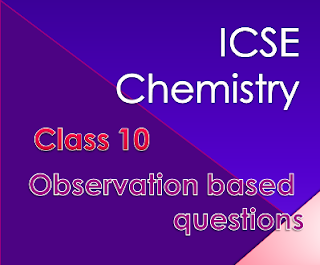OBSERVATIONS - AMMONIA
Click here to Subscribe to ICSE CHEMISTRY for Chapter-wise Notes Practice Papers Work sheets pdf files
State your observations when:
- The gas, which is produced by adding warm water to Magnesium nitride, is passes into Nesseler's reagent. Ans: That gas turns turns the Nessler's reagent to brown which gives a reddish brown precipitate.
- In fountain experiment using Ammonia gas. Ans: The litmus solution rises in the jet tube and ejects out like a fountain and turns blue.
- Oxidation of Ammonia gas in the absence of Catalyst. Ans: Ammonia gas burns with a green flame.
- Catalytic oxidation of Ammonia gas. Ans: Reddish brown fumes
- Copper sulphate solution is treated with small amounts of Ammonium hydroxide and then with excess. Ans: A pale blue precipitate is formed which turns into inky blue solution when excess Ammonium hydroxide is added.
- Zinc sulphate solution is treated with small amounts of Ammonium hydroxide and then with excess. Ans: A gelatinous white precipitate is formed which dissolves in excess Ammonium hydroxide.
- A solution containing Ferric ions solution is treated with small amounts of Ammonium hydroxide and then with excess. Ans: Reddish brown precipitate is formed which remains insoluble in excess Ammonium hydroxide.
- Reaction of Ammonia gas with excess Chlorine gas. Ans: Yellow liquid is formed.
- Excess Ammonia gas is treated with Chlorine gas. Ans: Dense white fumes
- Copper oxide is heated with Ammonia gas. Ans: Black copper oxide turns to brown residue.
- Ammonia gas is passed over heated Lead oxide. Ans: Silvery grey solid.
- Warm water is added to the product formed when Magnesium is burnt in Nitrogen. Ans: A colourless gas with pungent odour which turns Nessler's reagent to reddish brown precipitate.

No comments:
Post a Comment